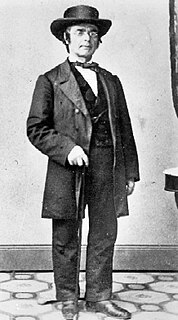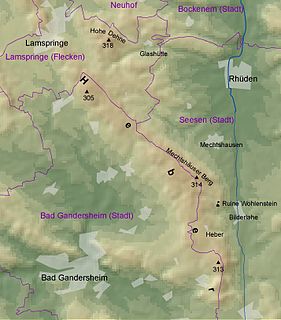
The Harz is a highland area in northern Germany. It has the highest elevations for that region, and its rugged terrain extends across parts of Lower Saxony, Saxony-Anhalt, and Thuringia. The name Harz derives from the Middle High German word Hardt or Hart, Latinized as Hercynia. The Brocken is the highest summit in the Harz with an elevation of 1,141.1 metres (3,744 ft) above sea level. The Wurmberg is the highest peak located entirely within the state of Lower Saxony.

Goslar is a district in Lower Saxony, Germany. It is bounded by the districts of Göttingen, Northeim, Hildesheim and Wolfenbüttel, the city of Salzgitter, and by the states of Saxony-Anhalt and Thuringia (Nordhausen).

Goslar is a historic town in Lower Saxony, Germany. It is the administrative centre of the district of Goslar and located on the northwestern slopes of the Harz mountain range. The Old Town of Goslar and the Mines of Rammelsberg are UNESCO World Heritage Sites for their millenium-long testimony to the history of ore mining and their political importance for the Holy Roman Empire and Hanseatic League. Each year Goslar awards the Kaiserring to an international artist, called the "Nobel Prize" of the art world.

Thale is a town in the Harz district in Saxony-Anhalt in central Germany. Located at the steep northeastern rim of the Harz mountain range, it is known for the scenic Bode Gorge stretching above the town centre.

Heinrich Engelhard Steinweg, anglicized name Henry Engelhard Steinway, was a German-American piano maker who made pianos in both Germany and the United States. He was the founder of the piano company Steinway & Sons.
Lutter am Barenberge is a market town (Flecken) and a former municipality in the Goslar district of Lower Saxony, Germany. Since 1 November 2021, it is part of the town Langelsheim, of which it is an Ortschaft. It was the administrative seat of the former Samtgemeinde Lutter am Barenberge

Langelsheim is a town in the district of Goslar in Lower Saxony, Germany.

Seesen is a town and municipality in the district of Goslar, in Lower Saxony, Germany. It is situated on the northwestern edge of the Harz mountain range, approx. 20 km (12 mi) west of Goslar.

Altenau is a town and a former municipality in the district of Goslar, in Lower Saxony, Germany. Since 1 January 2015 it is part of the town Clausthal-Zellerfeld.

Hahausen is a village and a former municipality in the district of Goslar in Lower Saxony, Germany. Since 1 November 2021, it is part of the town Langelsheim, of which it is an Ortschaft.
Wallmoden is a village and a former municipality in the district of Goslar in Lower Saxony, Germany. Since 1 November 2021, it is part of the town Langelsheim, of which it is an Ortschaft. It was the ancestral seat of the House of Wallmoden.
The Langelsheim–Altenau (Oberharz) railway was a railway line, that ran through the Upper Harz in Central Germany. It was also called the Upper Harz Railway or Harz Railway. It was built in order to enable the Magdeburg-Halberstadt Railway Company to access the mines in the Harz mountains.

The Grane is a river of Lower Saxony, Germany. It is a right tributary of the Innerste river near Goslar.

The formerly free mining town (Bergstadt) of Lautenthal in Germany is a state-recognised, climatic spa with around 1,570 inhabitants and has been part of the borough of Langelsheim since 1972.
The Neuekrug-Hahausen–Goslar railway is a double-tracked, non-electrified main line in Lower Saxony in central Germany. The line, which runs along the northern edge of the Harz mountains, begins in Goslar and forms a junction with the Brunswick–Kreiensen railway to Seesen and Kreiensen at Neuekrug-Hahausen. Because the branch-off station is passed through nowadays without stopping, it is often called the Goslar–Seesen railway. It is often described in the local area as the North Harz Line (Nordharzstrecke) but the term may cause confusion. The most important, and now the only, intermediate station is Langelsheim.

The B 243 runs from Hildesheim over Seesen and Herzberg am Harz to Nordhausen.

The Heber is a hogback ridge, relatively small in area and up to 313.5 metres high, in the Lower Saxon Hills within the districts of Goslar, Northeim and Hildesheim in the German state of Lower Saxony.
The Vienenburg–Langelsheim railway was a nearly 18-kilometer-long railway along the northern edge of the Harz in the German state of Lower Saxony. It was mainly used for freight traffic. It was opened in 1875, but it lost its importance with the closure of a line connecting to the east as a result of the division of Germany after the Second World War and it is now closed and dismantled.

Harz is an unincorporated area in the German district of Goslar.

Goslar – Northeim – Osterode is an electoral constituency represented in the Bundestag. It elects one member via first-past-the-post voting. Under the current constituency numbering system, it is designated as constituency 52. It is located in southern Lower Saxony, comprising most of the districts of Goslar, Northeim, and the former Osterode.




















